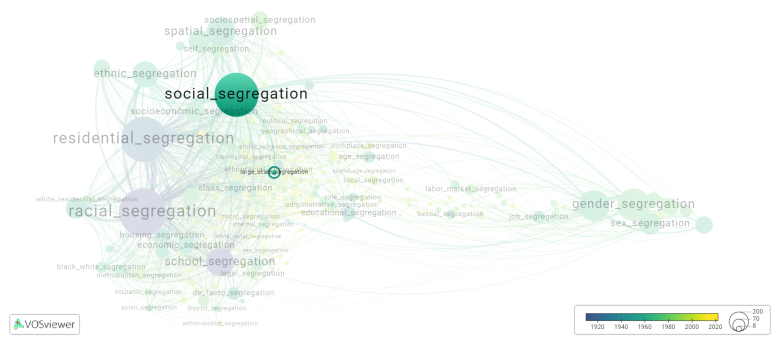Large scale segregation: Difference between revisions
(Creating page) |
(Creating page) |
||
| Line 14: | Line 14: | ||
Efforts to address large-scale segregation typically involve policies and programs aimed at promoting integration, equal access, and social inclusion. These may include initiatives such as affordable housing projects, school desegregation efforts, affirmative action policies, and anti-discrimination laws. However, achieving true integration and overcoming deeply ingrained patterns of segregation often requires sustained commitment and systemic changes. | Efforts to address large-scale segregation typically involve policies and programs aimed at promoting integration, equal access, and social inclusion. These may include initiatives such as affordable housing projects, school desegregation efforts, affirmative action policies, and anti-discrimination laws. However, achieving true integration and overcoming deeply ingrained patterns of segregation often requires sustained commitment and systemic changes. | ||
==See also== | ==See also== | ||
==Related segregation forms== | |||
Large scale segregation is frequently discussed in the literature with the following segregation forms: | |||
[[social segregation]], [[racial segregation]], [[residential segregation]] | |||
[[File:large_scale_segregation.png|780x780px]] | |||
For the complete network of associated segregation forms, see: | |||
year of publication https://tinyurl.com/2235lkhw | |||
Louvain clusters https://tinyurl.com/2d8wg5n3 | |||
betweenness centrality https://tinyurl.com/223udk5r | |||
disciplines where segregation forms first appeared https://tinyurl.com/244d8unz | |||
==References== | ==References== | ||
==Notes== | ==Notes== | ||
Revision as of 14:36, 27 September 2024
Date and country of first publication[1]
1962
United States
Definition
Large-scale segregation refers to the systematic separation of different racial, ethnic, or social groups throughout a society or within specific areas. This separation can occur through various means, such as housing patterns, educational institutions, public facilities, or social policies.
One notable example of large-scale segregation is the apartheid system that existed in South Africa from 1948 to 1994. Under apartheid, people were classified into different racial groups and subjected to different laws and policies based on their racial classification. This resulted in the enforced separation of racial groups in terms of where they lived, went to school, worked, and socialized.
Large-scale segregation can also be observed in the United States, particularly during the era of racial segregation known as Jim Crow. Prior to the Civil Rights Movement of the 1950s and 1960s, laws and policies enforced racial separation in public spaces, schools, housing, and other areas of life. This led to the creation of "separate but equal" facilities for Black and White individuals, with the Black facilities being significantly inferior in quality and resources.
In recent years, large-scale segregation has become a topic of concern in urban areas around the world. Many cities experience significant disparities in terms of access to quality housing, education, healthcare, and employment opportunities for different racial or socioeconomic groups. This often results in the concentration of marginalized or disadvantaged groups in specific neighborhoods, leading to higher levels of poverty, crime, and limited social mobility.
Efforts to address large-scale segregation typically involve policies and programs aimed at promoting integration, equal access, and social inclusion. These may include initiatives such as affordable housing projects, school desegregation efforts, affirmative action policies, and anti-discrimination laws. However, achieving true integration and overcoming deeply ingrained patterns of segregation often requires sustained commitment and systemic changes.
See also
Related segregation forms
Large scale segregation is frequently discussed in the literature with the following segregation forms:
social segregation, racial segregation, residential segregation

For the complete network of associated segregation forms, see:
year of publication https://tinyurl.com/2235lkhw
Louvain clusters https://tinyurl.com/2d8wg5n3
betweenness centrality https://tinyurl.com/223udk5r
disciplines where segregation forms first appeared https://tinyurl.com/244d8unz
References
Notes
- ↑ Date and country of first publication as informed by the Scopus database (December 2023).
At its current state, this definition has been generated by a Large Language Model (LLM) so far without review by an independent researcher or a member of the curating team of segregation experts that keep the Segregation Wiki online. While we strive for accuracy, we cannot guarantee its reliability, completeness and timeliness. Please use this content with caution and verify information as needed. Also, feel free to improve on the definition as you see fit, including the use of references and other informational resources. We value your input in enhancing the quality and accuracy of the definitions of segregation forms collectively offered in the Segregation Wiki ©.
Large scale segregation appears in the following literature
Lessinger J. (1962). The Case For Scatteration: Some Reflections on the National Capital Region Plan for the Year 2000. Journal of the American Planning Association, 28(3), 159-169. https://doi.org/10.1080/01944366208979438
Dohnke J., Heinrichs D., Kabisch S., Krellenberg K., Welz J. (2015). Achieving a Socio Spatial Mix? Prospects and Limitations of Social Housing Policy in Santiago de Chile. Housing Studies, 30(6), 839-857. Routledge.https://doi.org/10.1080/02673037.2014.982516
Saporito S., Van Riper D. (2016). Do irregularly shaped school attendance zones contribute to racial segregation or integration?. Social Currents, 3(1), 64-83. SAGE Publications Inc..https://doi.org/10.1177/2329496515604637
Andersson E.K., Malmberg B., Costa R., Sleutjes B., Stonawski M.J., de Valk H.A.G. (2018). A Comparative Study of Segregation Patterns in Belgium, Denmark, the Netherlands and Sweden: Neighbourhood Concentration and Representation of Non European Migrants. European Journal of Population, 34(2), 251-275. Springer Netherlands.https://doi.org/10.1007/s10680-018-9481-5
Gundersen V., Vistad O.I., Panzacchi M., Strand O., van Moorter B. (2019). Large scale segregation of tourists and wild reindeer in three Norwegian national parks: Management implications. Tourism Management, 75(), 22-33. Elsevier Ltd.https://doi.org/10.1016/j.tourman.2019.04.017
O’Connell H.A. (2019). Historical Shadows: The Links between Sundown Towns and Contemporary Black White Inequality. Sociology of Race and Ethnicity, 5(3), 311-325. SAGE Publications Inc..https://doi.org/10.1177/2332649218761979
